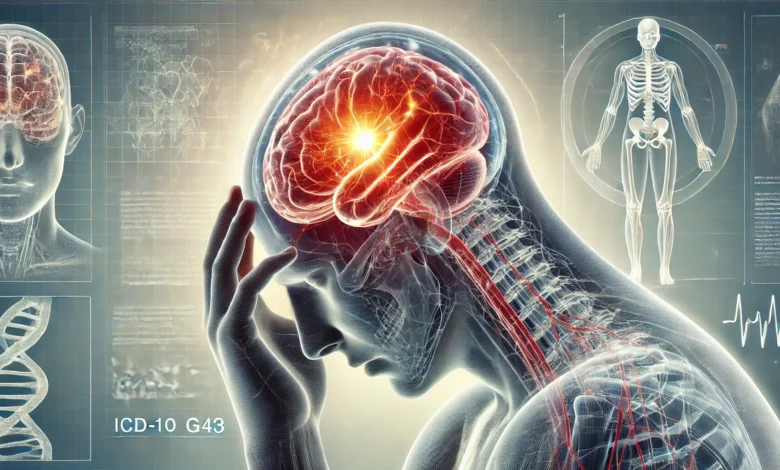Understanding CID10G43: A Deep Dive into Migraine Classification and Management

When you come across the term CID10G43, it might sound a bit technical or confusing at first glance. But in reality, this code represents something millions of people around the world experience every year — migraine. The code G43 is part of the International Classification of Diseases, 10th Revision (ICD-10), which is a global system used to classify and code health conditions. In simple terms, CID10G43 is the medical shorthand for migraine, helping healthcare professionals categorize, diagnose, and manage this often-debilitating condition with consistency and accuracy.
Let’s break down what CID10G43 really means, why it’s important, and how understanding it can make a huge difference in both patient care and research.
What Does CID10G43 Mean?
To understand CID10G43, it’s essential to first understand what CID-10 is. The acronym CID (or ICD, depending on the language) stands for Classificação Internacional de Doenças — in English, International Classification of Diseases. The 10 represents the 10th revision of this system, which is the version most commonly used worldwide today.
The G43 part of the code specifies the condition — Migraine. This includes a variety of subtypes such as:
- G43.0: Migraine without aura
- G43.1: Migraine with aura
- G43.2: Status migrainosus (a severe, long-lasting migraine attack)
- G43.3: Complicated migraine
- G43.9: Unspecified migraine
This coding system is not just for paperwork — it plays a huge role in healthcare documentation, insurance claims, and even research. By using a specific CID10G43 code, doctors and hospitals can easily identify and track migraine cases, study treatment effectiveness, and monitor public health trends.
In short, CID10G43 helps bring order to the complex world of medical diagnosis. It ensures that when one doctor says “migraine,” another doctor halfway around the world knows exactly what that means.
Why Migraine Deserves a Dedicated Code

Migraine is not just a headache — and that’s one of the main reasons it has its own dedicated classification under CID10G43. Unlike typical headaches that might come and go with stress or fatigue, migraines are neurological disorders that can be severely disabling. They often include symptoms like nausea, sensitivity to light and sound, visual disturbances, and even temporary loss of speech or coordination.
By giving migraine its specific code, healthcare systems acknowledge it as a serious medical condition that requires proper diagnosis, management, and research. This classification allows doctors to differentiate migraines from other types of headaches such as:
- Tension headaches, which are more common and less severe
- Cluster headaches, which occur in cyclical patterns or clusters
- Secondary headaches, caused by underlying conditions like infections or high blood pressure
Each of these has different causes, treatments, and implications, so accurate coding is essential for proper care. CID10G43 allows clinicians to record the type of migraine precisely, leading to better treatment planning and more accurate health statistics.
The Clinical Importance of CID10G43 in Healthcare
In the medical field, documentation is everything. A correct diagnosis code like CID10G43 ensures that a patient’s medical records are accurate, which affects everything from treatment decisions to insurance coverage.
For example, a patient suffering from CID10G43 (Migraine with aura) might experience warning signs before the actual headache begins — like flashes of light, blind spots, or tingling sensations. These symptoms help doctors distinguish this type from G43.0 (Migraine without aura), where no warning symptoms appear. That difference might seem small, but it has a big impact on treatment strategies and medication choices.
Moreover, hospitals and insurance companies rely on CID10 codes for billing and claim processing. If a patient is diagnosed under CID10G43, it immediately signals the type of care, treatment, and even medication that might be necessary. This level of precision reduces confusion, minimizes errors, and ensures fair reimbursement for medical services.
On a broader scale, researchers use CID10G43 data to analyze trends in migraine cases worldwide — understanding patterns, studying triggers, and developing more effective treatments.
Understanding the Subcategories of CID10G43
One of the strengths of the CID10G43 classification is that it doesn’t just lump all migraines together. It breaks them into subtypes to reflect the wide range of experiences migraine patients can have. Let’s look at a few key ones:
CID10G43 – Migraine Without Aura
This is the most common type of migraine. Patients experience intense, throbbing pain on one side of the head, usually accompanied by nausea and sensitivity to light or sound. Attacks can last anywhere from 4 to 72 hours, and triggers may include stress, lack of sleep, hormonal changes, or certain foods.
G43.1 – Migraine With Aura
In this subtype, neurological symptoms (known as an aura) precede the headache phase. Patients might see zigzag lines, flashing lights, or even lose vision temporarily. Some experience tingling or numbness in their hands or face. These warning signs give patients a chance to prepare or take medication early, potentially reducing the severity of the attack.
G43.2 – Status Migrainosus
This is a severe and prolonged migraine that lasts more than 72 hours, often requiring medical intervention. Patients may need hospitalization for intravenous fluids and pain relief. It’s considered a medical emergency due to the high risk of dehydration and other complications.
G43.9 – Unspecified Migraine
This code is used when a migraine diagnosis is confirmed but lacks enough detail to categorize it further. It serves as a temporary classification until more specific symptoms or patterns emerge.
These subcategories help healthcare professionals fine-tune their diagnosis and provide more personalized care.
The Role of CID10G43 in Research and Public Health
Beyond hospitals and clinics, the CID10G43 code is also invaluable for public health surveillance and medical research. By tracking how often migraine codes are used, researchers can study trends — such as which age groups or regions are most affected. This data helps identify risk factors and supports the development of prevention strategies.
Pharmaceutical companies also rely on this data when developing new migraine medications. For instance, studies analyzing CID10G43 cases helped pave the way for CGRP inhibitors, a new class of drugs designed specifically for migraine prevention.
Furthermore, public health organizations use this data to raise awareness about migraines as a legitimate, often disabling condition. This not only helps patients receive better support but also reduces the stigma around migraine-related disorders.
How CID10G43 Affects Patients Directly
For patients, understanding what CID10G43 means can be empowering. It clarifies that their condition is recognized globally as a legitimate medical issue — not just “a bad headache.” Knowing their exact diagnosis code can also help when dealing with insurance claims, second opinions, or even when researching treatment options online.
Patients can use CID10G43 information to better communicate with healthcare providers. For instance, if someone has recurrent migraines with aura, noting that their diagnosis is G43.1 helps doctors quickly identify their case type and decide on the right preventive or acute treatment.
Additionally, patient awareness of CID10G43 contributes to better migraine management. By understanding the triggers, types, and potential complications outlined in this classification, individuals can take proactive steps toward controlling their symptoms and improving their quality of life.
Conclusion: Why CID10G43 Matters More Than You Think
At first glance, CID10G43 might look like just another technical medical code — but it’s much more than that. It’s a global standard that gives clarity, structure, and precision to the diagnosis of migraines. From helping doctors make accurate decisions, to supporting research, to ensuring fair insurance coverage, CID10G43 plays a crucial role in modern healthcare.
For patients, this code represents recognition — that their pain is real, their condition is understood, and their care can be managed systematically. In a world where migraines affect millions, CID10G43 helps bridge the gap between medical science and human experience, making sure every case counts and every patient is heard.



